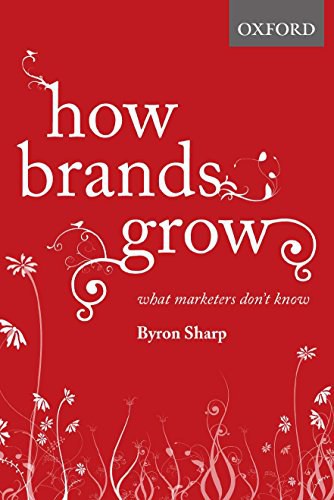Why Brands Grow: What Marketers Don’t Know, (AU) Byron Sharp, Oxford University Press, 2010, 246 pages.
这本书是澳大利亚一名专门从事Marketing研究和教学的教授写的。其出发点是质疑一切既定Marketing主流理论与观点,狂喷了美国知名营销教授Kotler、定位专家特劳特等人,用实证来验证究竟什么行得通什么行不通。
第一章讲的是Marketing是实战工具,要用事实来说明,而不是仅仅听权威大咖们怎么说。
第2章详解了Double Jeopardy law。这个有点像马太效应,强者越强。
第三章说的是想扩大市场份额,与其花力气挽留老客户,不如把精力和资源花在获取新客户上面。
第四章说的是不该只营销瞄准重度用户,帕累托法则不适用(作者在挑战传统既定思维),各个层级的用户都要精巧地涉及,只有这样才能让市场份额增长。“20:30:50 buyers accounting for 50:30:20 purchases.”
第五章讲的是差异化并没有事实根据,同一商品类别里不同品牌的客户之间并没有多大差别,因此你的目标客户群应该很大,不需要市场细分,当然竞争对手也会这样看。
第6章讲的是在大市场内大家的竞争对手都是一样的,都是大品牌,细分市场无意义。因为小品牌的客户都同时买大品牌的东西。提高市场份额的做法最简单的是让产品触手可及。
第七章讲的是品牌忠诚度没那么重要。真正忠诚的客户其实买的不多;买的多的是那些不怎么在乎的客户。
第8章讲的是差异化的迷思。差异化没那么重要。相反,让自己的品牌更突出更重要。说实话我个人有点分不清差异化和这个所谓的突出的差别。
第9章讨论的是如何做广告更有用。广告是有作用的,但对销售的促进不是即时的,需要很长时间才能显现,或者是跟对手竞争,不会因为没做广告而损失销售。作者认为做广告重要的是要突出,有特点,广告能增强受众的记忆,让他们知道在哪里买。
第10章讲的是价格。好品牌往往不便宜。降价即使短期能拉动销售,仍然对长期不利。当然中国不少商家有意把价格虚假拉高,然后打折,其实卖的还是原价,这就是无商不奸了。
第11章讲的是会员制没啥用,都是给现有忠诚用户的,吸引不了竞争对手的客户。
第12章是一个总结,讲的是Marketing竞争的是物理和心理上的可及性,让商品占领潜在客户心智,并触手可及地容易买到。让你的商品突出、可见。Marketing传递的信息要一致并且有新意。少给客户制造不买你的理由。
作者给出的7个Marketing建议是:
“1.Continuously reach all buyers of the brand’s service/product category, with both physical distribution and marketing communication.2.Ensure the brand is easy to buy.3.Get noticed. Often.4.Refresh and build brand-linked memory structures that make the brand easier to notice and buy.5.Create distinctive communication assets.6.Be consistent, yet fresh and interesting.7.Stay competitive, keep up the mass appeal; don’t give customers reasons not to buy the brand.”
第13章是作者书中提到的各种定律的总和。第14章是一些常见问题及作者的回复。
2016年有出中文版,名字叫《非传统营销》,中信出版社出版。 22年作者又和别人合作出了续集,How Brands Grow Part 2 Revised。
这本书不长但字字珠玑,值得反复阅读体会。很多数据和图表来说明作者的观点。不管作者观点对错,只要在辩解的过程中大家有思考,有收获,也就算获益了。
其他一些金句摘抄:
“for maintenance or growth, a brand’s marketing has to somehow, at least over time, reach all the buyers in a category.”
“1. Acquisition is vital for growth and maintenance.2. Reaching all buyers is vital, especially light, occasional buyers of the brand.”
“Brand managers prefer category definitions that make their brand appear to have a substantial market share.”
“Familiarity breeds liking. Usage also breeds familiarity and brand knowledge; this in turn breeds liking.”
“Reach is important for brand growth.•In-store promotions generally lack reach, but retailer advertising has much broader reach.•Price promotions may not be profitable, particularly when the price cut is deep.•There is the possibility that reference prices would be eroded, particularly from deep price cuts.•However, manufacturers often feel pressurised to participate in price promotions.”
“Letting the price of a brand slightly below that of the biggest brands in the category may be a better tactic than either deeply undercutting the leaders’ prices, or setting the price close to the leader’s price, but not undercutting it.”
“The key marketing task is to make a brand always easy to buy for every buyer; this requires building mental and physical availability.”


